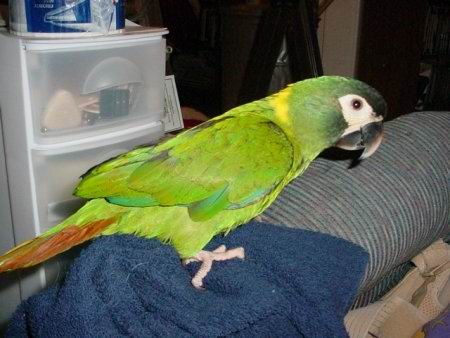Macaw - Yellow Collared
Yellow-Naped Macaw, Goldnackenara Scientific Name: Ara auricollis
Fri, 1st November, 2024 - 4:24 am GMT
Sponsor Ads:

Alternative Name
Yellow-Naped Macaw, Goldnackenara Scientific Name: Ara auricollisBasic Info
Male and female Yellow Collared Macaws do not differ in appearance. It is generally true that females are smaller than males, but size is not a reliable method of distinguishing sex. Some also hold that the males exhibit a larger yellow neck collar than females, but again this is unreliable. If you wish to know whether yours is a male of female it is recommended to take them to your local avian veterinarian for testing. The Mini Macaw can only be described as beautiful. His plumage is largely green, but what makes it so spectacular are all the other colors splashed elsewhere on his body. His nape possesses a yellow band and a bluish tinge is seen decorating those feathers. The secondaries and greater wing covets are also splashed with blue. And blue is the primary color for the primary-coverts and primary wing feathers as well. The under wing coverts are an olive yellow. His tail feathers are light maroon turning blue at the ends. His bill is entirely black except for the tip which is horn colored. Brownish-black feathers cover the cheeks (whitish naked skin area in the cheek area as well), crown and forehead. His eyes possess an orange iris and he generally will have gray feet, though one owner reports hers has pink feet! Immatures can be easily distinguished with their more horn colored bills and the narrower nape band. They are smaller than most macaws measuring 15 inches (38cm) at adulthood with weights of 230 to 250 grams on average.
Health
If left alone the Yellow Collared Macaw can become very noisy. Breeding The breeding season of the Yellow Collared Macaw begins in December in the wild, but breeding in captivity begins in May. The hen will lay a clutch of three to four eggs. The incubation period lasts 26 days with the babies being fledged in 12 weeks. Breeding in captivity is regularly achieved.Habitat
N/ABehavior
The Yellow Collared Macaw, also known as the Mini Macaw may be small in size, but he is very large in personality and beauty. It is no surprise that the Yellow Collared Macaw is a favorite among many parrot fanciers. If you want the personality of a large Macaw in a small package the Yellow Collared Macaw might just be for you! The Yellow Collared Macaw has a pleasant disposition, particularly when bred in captivity and hand raised. They are classified as medium to noisy parrots, but they are much quieter than other species of macaw. The Yellow Collared Macaw is a highly intelligent birds who display quick learning. In addition many are capable of speaking. There are never any guarantees that your bird will talk, but several owners of Yellow Collared Macaws have reported good mimicking ability. They are sweet and loving birds, many of whom love to be cuddled by their owners. They may not do well in homes which are noisy of have small children, this is because they have a tendency to become nervous and jumpy when large amounts of noise are present in the home.Origin
South AmericaHistory
The Yellow Collared Macaw originates in South America. They are a highly social bird in the wild and can be seen frequently in flocks of 10 to 20, and gathering of flocks can be seen in numbers as high as 500.Common Foods
N/ASponsor Ads:
When the mouse laughs at the cat, there is a hole very near by. -- Unknown
Macaw - Yellow Collared
Coded by: BGID® | ALL RIGHTS RESERVED Copyright © 2000-2024
Disclaimer | Privacy | Report Errors / Contact | Credits








 Homosexual behavior stems from the mind or genetics?
Homosexual behavior stems from the mind or genetics?  The Best Text Adventure You Will Ever Play! The official site:
The Best Text Adventure You Will Ever Play! The official site:  Why haven't we as a collective earth met with aliens yet?
Why haven't we as a collective earth met with aliens yet?  World EcoSystem - Biodiversity Changes - Who is on board and who isn
World EcoSystem - Biodiversity Changes - Who is on board and who isn  Mouthwash - Mouthrinse - Mouth Sores - Healing Infections - Gingivitis
Mouthwash - Mouthrinse - Mouth Sores - Healing Infections - Gingivitis  Treatment for Depression
Treatment for Depression  Ultra radical and violent Islamist group that even rivals Al Qaeda
Ultra radical and violent Islamist group that even rivals Al Qaeda  An idea to have teachers who want to carry guns to school undergo some level of police training will be left up to local school districts and police departments.
An idea to have teachers who want to carry guns to school undergo some level of police training will be left up to local school districts and police departments.